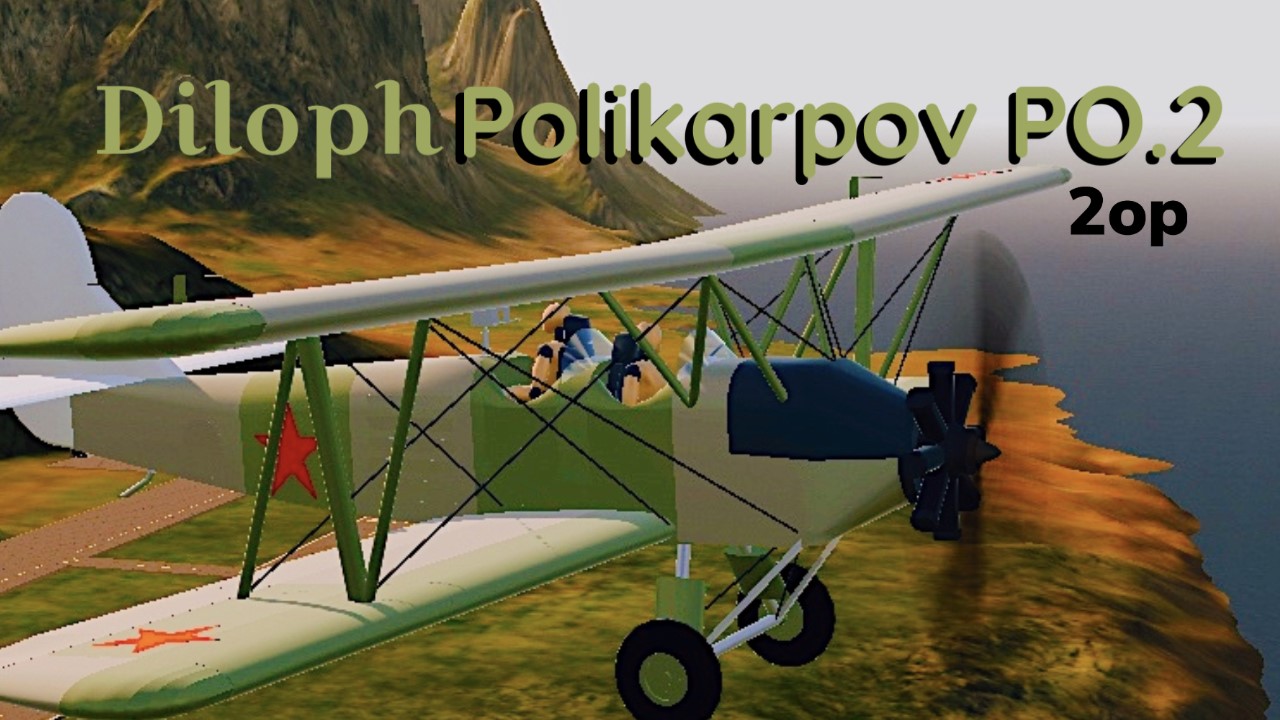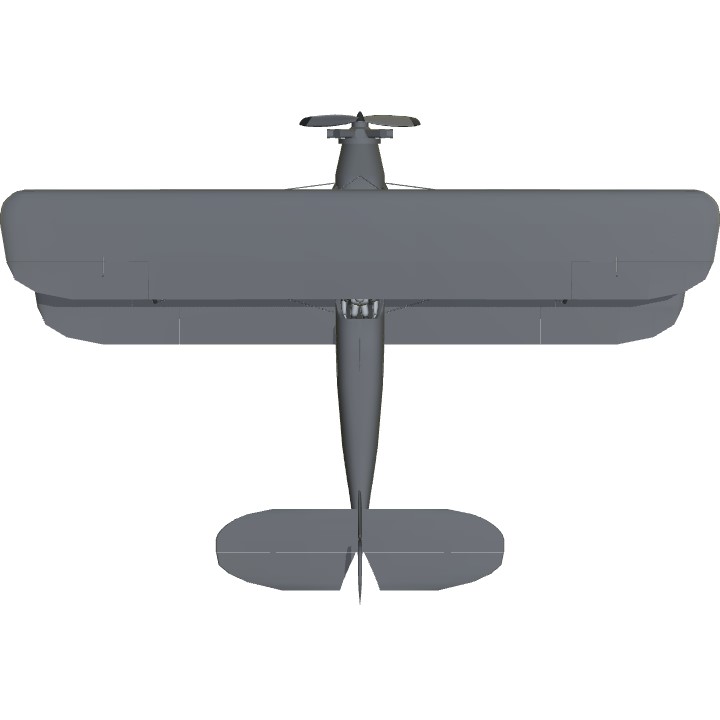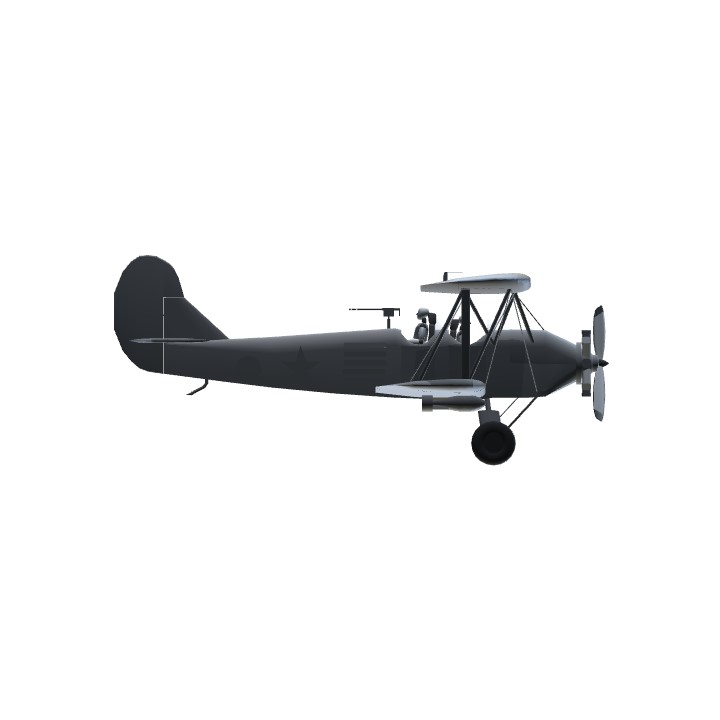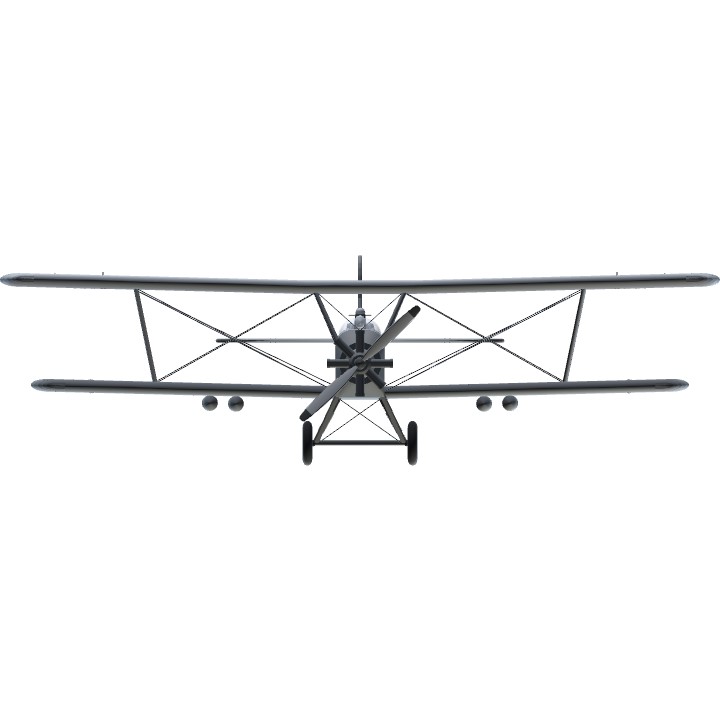Welcome!
Controls
AG-1 activates control surfaces
AG-2 activates gunner
Use trim to keep level while using gunner
No flaps
Pictures



WIKI
The aircraft was designed by Nikolai Polikarpov to replace the U-1 trainer (a copy of the British Avro 504), which was known as Avrushka to the Soviets.
The prototype of the U-2, powered by a 74 kW (99 hp) Shvetsov M-11 air-cooled five-cylinder radial engine, first flew on 7 January 1928 piloted by M.M. Gromov. Aircraft from the preproduction series were tested at the end of 1928 and serial production started in 1929 in Factory number 23 in Leningrad. Its name was changed to Po-2 in 1944, after Polikarpov's death, according to the then-new Soviet naming system, usually using the first two letters of the designer's family name, or the Soviet government-established design bureau that created it. Production in the Soviet Union ended in 1953, but license-built CSS-13s were still produced in Poland until 1959.
From the beginning, the U-2 became the basic Soviet civil and military trainer aircraft, mass-produced in a "Red Flyer" factory near Moscow. It was also used for transport, and as a military liaison aircraft, due to its STOL capabilities. Also from the beginning it was produced as an agricultural aircraft variant, which earned it its nickname Kukuruznik. Although entirely outclassed by contemporary aircraft, the Kukuruznik served extensively on the Eastern Front in World War II, primarily as a liaison, medevac and general-supply aircraft. It was especially useful for supplying Soviet partisans behind the German front line. Manufacturing of the Po-2 in the USSR ceased in 1949, but until 1959 a number were assembled in Aeroflot repair workshops.
The first trials of arming the aircraft with bombs took place in 1941.
During the defence of Odessa, in September 1941, the U-2 was used as a reconnaissance aircraft and as a light, short-range, bomber. The bombs, dropped from a civil aircraft piloted by Pyotr Bevz, were the first to fall on enemy artillery positions.[6] From 1942 it was adapted as a light night ground attack aircraft.
Nikolay Polikarpov supported the project, and under his leadership, the U-2VS (voyskovaya seriya - Military series) was created. This was a light night bomber, fitted with bomb carriers beneath the lower wing, to carry 50 or 100 kg (110 or 220 lbs) bombs up to a total weight of 350 kg (771 lb) and armed with ShKAS or DA machine guns in the observer's cockpit.[6]
The U-2's 5-cylinder engine had an unusual exhaust manifold arrangement that gave the engine a peculiar rattling or popping sound and led to a number of nicknames. Wehrmacht troops nicknamed it Nähmaschine (sewing machine), and Finnish troops called it Hermosaha (Nerve saw)[citation needed]. The Germans also called it Kaffeemühle, which literally means "coffee grinder" and is also slang meaning "whirlybird," probably for the engine which could sound like the rotating blades of a helicopter in flight. The fabric and wood construction of the airplane made it extremely vulnerable to catching fire, resulting in a Russian nickname of Kerosinka, or kerosene lantern.[7]
The material effects of these missions may be regarded as minor, but the psychological effect on German troops was noticeable. They typically attacked by surprise in the middle of the night, denying German troops sleep and keeping them on their guard, contributing to the already high stress of combat on the Eastern front. The usual tactic involved flying only a few meters above the ground, climbing for the final approach, throttling back the engine and making a gliding bombing run, leaving the targeted troops with only the eerie whistling of the wind in the wings' bracing-wires as an indication of the impending attack.[8] Luftwaffe fighters found it extremely hard to shoot down the Kukuruznik because of two main factors: the pilots flew at treetop level where they were hard to see or engage and the stall speed of both the Messerschmitt Bf 109 and the Focke-Wulf Fw 190 was similar to the U-2s maximum speed, making it difficult for the fighters to keep a Po-2 in weapons range for an adequate period of time.[9] The success of the Soviet night harassment units inspired the Luftwaffe to set up similar Störkampfstaffel "harassment combat squadrons" on the Eastern Front using their own obsolete 1930s-era, open cockpit biplanes (most often the Gotha Go 145 and Arado Ar 66 biplanes) and parasol monoplane aircraft, eventually building up to larger Nachtschlachtgruppe (night attack group) units of a few squadrons each.
The U-2 became known as the aircraft used by the 588th Night Bomber Regiment, composed of an all-woman pilot and ground crew complement. The unit was notorious for daring low-altitude night raids on German rear-area positions. Veteran pilots Yekaterina Ryabova and Nadezhda Popova on one occasion flew eighteen missions in a single night. The women pilots observed that the enemy suffered a further degree of demoralization simply due to their antagonists being female. As such, the pilots earned the nickname "Night Witches" (German Nachthexen, Russian ?????? ??????/Nocnye Ved’my). The unit earned numerous Hero of the Soviet Union citations and dozens of Order of the Red Banner medals; most surviving pilots had flown nearly 1,000 combat missions by the end of the war and took part in the Battle of Berlin.
The Polish Air Force used these slow and manoeuvrable aircraft for air reconnaissance and COIN operations against UPA detachments in mountainous area of Bieszczady. Pilots and navigators were dispatched to look for concentrations of UPA forces and if needed, engage them with machine guns and grenades. On several occasions, the UPA managed to bring down some of the Po-2s, but never captured or operated them.[10]
North Korean forces used the Po-2 in a similar role during the Korean War. A significant number of Po-2s were fielded by the Korean People's Air Force, inflicting serious damage during night raids on United Nations bases.[11] During one such attack, a lone Po-2 attacked Pyongyang airfield in northwestern Korea. Concentrating on the 8th Fighter-Bomber Group's parking ramp, the Po-2 dropped a string of fragmentation bombs squarely across the group's lineup of P-51 Mustangs. Eleven Mustangs were damaged, three so badly that they were destroyed when Pyongyang was abandoned several days later.
On 17 June 1951, at 01:30 hours, Suwon Air Base was bombed by two Po-2s. Each biplane dropped a pair of fragmentation bombs. One scored a hit on the 802nd Engineer Aviation Battalion's motor pool, damaging some equipment. Two bombs burst on the flightline of the 335th Fighter Interceptor Squadron. One F-86A Sabre (FU-334 / 49-1334) was struck on the wing and began burning. The fire took hold, gutting the aircraft. Prompt action by personnel who moved aircraft away from the burning Sabre prevented further loss. Eight other Sabres were damaged in the brief attack, four seriously. One F-86 pilot was among the wounded. The North Koreans subsequently credited Lt. La Woon Yung with this damaging attack.[12]
UN forces named the Po-2's nighttime appearance Bedcheck Charlie and had great difficulty in shooting it down – even though night fighters had radar as standard equipment in the 1950s. The wood-and-fabric material of the Po-2 had only a small radar cross-section, making it hard for an opposing fighter pilot to acquire his target. As Korean war U.S. veteran Leo Fournier remarked about "Bedcheck Charlie" in his memoirs: "... no one could get at him. He just flew too low and too slow." On 16 June 1953, a USMC AD-4 from VMC-1 piloted by Major George H. Linnemeier and CWO Vernon S. Kramer shot down a Soviet-built Polikarpov Po-2 biplane, the only documented Skyraider air victory of the war. The Po-2 is also the only biplane credited with a documented jet-kill, as one Lockheed F-94 Starfire was lost while slowing down to 161 km/h (100 mph) – below its stall speed – during an intercept in order to engage the low flying Po-2.[13]
Diloph
-bigchunguss
Specifications
General Characteristics
- Successors 1 airplane(s) +14 bonus
- Created On iOS
- Wingspan 55.7ft (17.0m)
- Length 38.1ft (11.6m)
- Height 16.3ft (5.0m)
- Empty Weight 10,737lbs (4,870kg)
- Loaded Weight 14,576lbs (6,611kg)
Performance
- Horse Power/Weight Ratio 0.205
- Wing Loading 14.9lbs/ft2 (72.7kg/m2)
- Wing Area 979.5ft2 (91.0m2)
- Drag Points 9177
Parts
- Number of Parts 347
- Control Surfaces 0
- Performance Cost 1,127





From the depths of hell in slienc- Oh uh, very nice build
@Tookan yah I know thanks for pointing that out :-|
@Molasses
it's not even in WT anymore
This is most OP plane in war thunder.
Night witches intensifies
Yeah agreeee@EternalDarkness
@BreadDoBeKindaSus oh, I understand the burnout. I hope you'll revisit this build in the future though, it's a really good base.
I only know this from the yt channel Tarmeow xd
Yeah agree, not gonna lie I felt as I couldn’t put my care in this build, I was burnt out, but I agree truly thanks!@EternalDarkness
2.OP
We cant do night witches w/out bomb
If the part count is the issue, you can make a pretty decent machine gun with a hinge rotator without a base and a wing gun. Add disc mag on top of it, and you have a machine gun that can possibly be found on a real Po-2. As for the engine, you can try using rotator bases to give it ribs. Real one only has five cylinders and a bulky center mass. It might be even fewer parts than what you currently have.
Look it's alright
But like ED below me said, it's just missing basic details and other things
Frankly, I was expecting more. You have a very good base here, but you should have invested a bit more into tweaking performance, adding some gauges, engine details, and making a proper gun. The one you have is a box on a stick with a pipe in it. Turret ring and a simple machine gun would have only taken additional dozen or so parts. Also, having machine gun fire regardless of activation group while allowing tail to take damage is bad. Accidentally pressing the trigger blows the tail fin off. I suggest setting the machine gun to
activate1, setting machine gun rotators toactivate1, and setting control surface rotators to-activate1, withZeroOnDeactivateset totrue. Also, I suggest putting the cockpit to where the pilot PoV is.This build isn't far from being great, it only needs some tweaks, but without those tweaks it's quite bad.
51st
@asteroidbook345 and even Rafale
So stronk it can beat western F-35
Love the po-2
biplane jet kill time
Uh@Liquidfox01
Stunning, now make it float haha